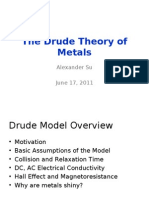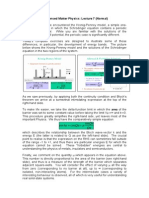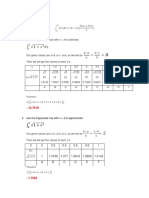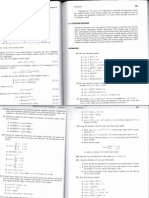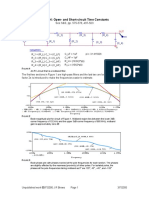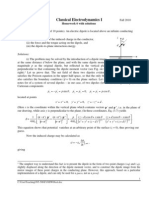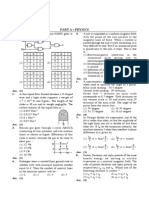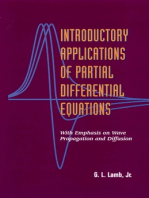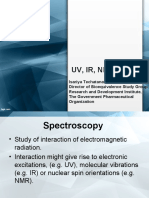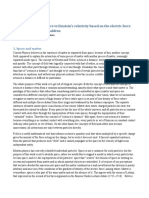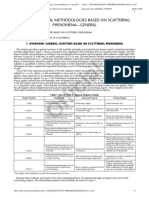EE145 HMWK 5 Sol
EE145 HMWK 5 Sol
Uploaded by
deepakkr22781Copyright:
Available Formats
EE145 HMWK 5 Sol
EE145 HMWK 5 Sol
Uploaded by
deepakkr22781Original Description:
Original Title
Copyright
Available Formats
Share this document
Did you find this document useful?
Is this content inappropriate?
Copyright:
Available Formats
EE145 HMWK 5 Sol
EE145 HMWK 5 Sol
Uploaded by
deepakkr22781Copyright:
Available Formats
EE145 Spring 2002
Homework 5 Solution
Prof. Ali Shakouri
Second Edition ( 2001 McGraw-Hill)
Chapter 5
5.1 Bandgap and photodetection
a. Determine the maximum value of the energy gap that a semiconductor, used as a photoconductor,
can have if it is to be sensitive to yellow light (600 nm).
b. A photodetector whose area is 5 10-2 cm2 is irradiated with yellow light whose intensity is 2 mW
cm-2. Assuming that each photon generates one electron-hole pair, calculate the number of pairs
generated per second.
c. From the known energy gap of the semiconductor GaAs (Eg = 1.42 eV), calculate the primary
wavelength of photons emitted from this crystal as a result of electron-hole recombination.
d. Is the above wavelength visible?
e. Will a silicon photodetector be sensitive to the radiation from a GaAs laser? Why?
Solution
a
We are given the wavelength = 600 nm, therefore we need Eph = h = Eg so that,
Eg = hc/ = (6.626 10-34 J s)(3.0 108 m s-1) / (600 10-9 m)
Eg = 3.31 10-19 J or 2.07 eV
Area A = 5 10-2 cm2 and light intensity Ilight = 2 10-3 W/cm2. The received power is:
P = AIlight = (5 10-2 cm2)(2 10-3 W/cm2) = 1.0 10-4 W
Nph = number of photons arriving per second = P/Eph
Nph = (1.0 10-4 W) / (3.31 10-19 J) = 3.02 1014 Photons s-1
Since the each photon contributes one electron-hole pair (EHP), the number of EHPs is then:
NEHP = 3.02 1014 EHP s-1
For GaAs, Eg = 1.42 eV and the corresponding wavelength is
= hc/Eg = (6.626 10-34 J s)(3.0 108 m s-1) / (1.42 eV 1.602 10-19 J/eV)
= 8.74 10-7 m or 874 nm
The wavelength of emitted radiation due to electron-hole pair (EHP) recombination is therefore
874 nm.
d
It is not in the visible region (it is in the infrared).
e
is,
From Table 5.1 (in the textbook), for Si, Eg = 1.10 eV and the corresponding cut-off wavelength
g = hc/Eg = (6.626 10-34 J s)(3.0 108 m s-1) / (1.1 eV 1.602 10-19 J/eV)
g = 1.13 10-6 m or 1130 nm
5.1
Homework 5 Solution
EE145 Spring 2002
Prof. Ali Shakouri
Since the 874 nm wavelength of the GaAs laser is shorter than the cut-off wavelength of 1130
nm, the Si photodetector can detect the 874 nm radiation (Put differently, the photon energy
corresponding to 874 nm, 1.42 eV, is larger than the Eg, 1.10 eV, of Si which means that the Si
photodetector can indeed detect the 874 nm radiation).
5.2 Minimum conductivity
a. Consider the conductivity of a semiconductor, = ene + eph. Will doping always increase the
conductivity?
b. Show that the minimum conductivity for Si is obtained when it is p-type doped such that the hole
concentration is
pm = ni
e
h
and the corresponding minimum conductivity (maximum resistivity) is
min = 2eni e h
c. Calculate pm and min for Si and compare with intrinsic values.
Solution
a
Doping does not always increase the conductivity. Suppose that we have an intrinsic sample
with n = p but the hole drift mobility is smaller. If we dope the material very slightly with p-type then p
> n. However, this would decrease the conductivity because it would create more holes with lower
mobility at the expense of electrons with higher mobility. Obviously with further doping p increases
sufficiently to result in the conductivity increasing with the extent of doping.
b
To find the minimum conductivity, first consider the mass action law:
np = ni2
isolate n:
n = ni2/p
Now substitute for n in the equation for conductivity:
= ene + eph
eni2 e
=
+ h ep
p
To find the value of p that gives minimum conductivity (pm), differentiate the above equation
with respect to p and set it equal to zero:
d
eni2 e
=
+ h e
2
dp
p
eni 2 e
+ h e = 0
pm 2
Isolate pm and simplify,
5.2
Homework 5 Solution
EE145 Spring 2002
pm = ni
Prof. Ali Shakouri
e
h
Substituting this expression back into the equation for conductivity will give the minimum
conductivity:
min
e
eni2 e
eni 2 e
=
+ hep m =
+ h eni
pm
ni e h
h
h
+ eni e h = eni e h + eni e h
e
min = eni e
min = 2eni e h
c
From Table 5.1, for Si: e = 1350 cm2 V-1 s-1, h = 450 cm2 V-1 s-1 and ni = 1.45 1010 cm-3.
Substituting into the equations for pm and min:
pm = ni
e
1350 cm 2 V1 s1
10
3
10
= (1.45 10 cm )
cm-3
2
1
1 = 2.51 10
h
450 cm V s
min = 2eni e h
min = 2(1.602 1019 C)(1.45 1010 cm3 ) (1350 cm2 V1 s1 )(450 cm2 V1 s1 )
min = 3.62 10-6 -1 cm-1
The corresponding maximum resistivity is:
max = 1 / min = 2.76 105 cm
The intrinsic value corresponding to pm is simply ni (= 1.45 1010 cm-3). Comparing it to pm:
pm 2.51 1010 cm 3
=
= 1.73
ni 1.45 1010 cm3
The intrinsic conductivity is:
int = eni(e + h)
int = (1.602 10-19 C)(1.45 1010 cm-3)(1350 cm2 V-1 s-1 + 450 cm2 V-1 s-1)
int = 4.18 10-6 -1 cm-1
Comparing this value to the minimum conductivity:
int 3.62 10 6 W 1 cm1
=
= 0.866
min 4.18 10 6 W -1 cm-1
Sufficient p-type doping that increases the hole concentration by 73% decreases the conductivity
by 15% to its minimum value.
5.3 Compensation doping in Si
a. A Si wafer has been doped n-type with 1017 As atoms cm-3.
1. Calculate the conductivity of the sample at 27 C.
5.3
Homework 5 Solution
EE145 Spring 2002
Prof. Ali Shakouri
2. Where is the Fermi level in this sample at 27 C with respect to the Fermi level (EFi) in intrinsic
Si?
3. Calculate the conductivity of the sample at 127 C.
b. The above n-type Si sample is further doped with 9 1016 boron atoms (p-type dopant) per
centimeter cubed.
1. Calculate the conductivity of the sample at 27 C.
2. Where is the Fermi level in this sample with respect to the Fermi level in the sample in (a) at 27
C? Is this an n-type or p-type Si?
Solution
Given temperature T = 27 C = 300 K, concentration of donors Nd = 1017 cm-3, and drift mobility
e 800 cm2 V-1 s-1 (from Figure 5Q3-1). At room temperature the electron concentration n = Nd >> p
(hole concentration).
a
2000
1000
Holes
Electrons
100
50
1015
1016
1017
1018
Dopant Concentration,
1019
1020
cm-3
Figure 5Q3-1 The variation of the drift mobility with dopant concentration in Si
for electrons and holes at 300 K.
(1)
The conductivity of the sample is:
= eNde (1.602 10-19 C)(1017 cm-3)(800 cm2 V-1 s-1) = 12.8 -1 cm-1
(2)
In intrinsic Si, EF = EFi,
ni = Ncexp[(Ec EFi)/kT]
(1)
In doped Si, n = Nd, EF = EFn,
n = Nd = Ncexp[(Ec EFn)/kT]
(2)
Eqn. (2) divided by Eqn. (1) gives,
Nd
E EFi
= exp Fn
ni
kT
(3)
N E EFi
ln d = Fn
kT
ni
5.4
Homework 5 Solution
EE145 Spring 2002
Prof. Ali Shakouri
EF = EFn EFi = kT ln(Nd/ni)
(4)
Substituting we find (ni = 1.45 1010 cm-3 from Table 5.1 in the textbook),
EF = (8.617 10-5 eV/K)(300 K)ln[(1017 cm-3)/ (1.45 1010 cm-3)]
EF = 0.407 eV above Efi
50000
LT1.5
Ge
Nd =1014
10000
Nd =1016
Nd =1013
Nd =1017
1000
Nd =1018
100
Nd =1019
Si
T1.5
10
70
100
Temperature (K)
800
Figure 5Q3-2 Log-log plot for drift mobility versus temperature for n-type Ge
and n-type Si samples. Various donor concentrations for Si are shown, Nd are in
cm-3. The upper right insert is the simple theory for lattice limited mobility
whereas the lower left inset is the simple theory for impurity scattering limited
mobility.
(3)
At Ti = 127 C = 400 K, e 450 cm2 V-1 s-1 (from Figure 5Q3-2). The semiconductor is still ntype (check that Nd >> ni at 400 K), then
= eNde (1.602 10-19 C)(1017 cm-3)(450 cm2 V-1 s-1) = 7.21 -1 cm-1
b
The sample is further doped with Na = 9 1016 cm-3 = 0.9 1017 cm-3 acceptors. Due to
compensation, the net effect is still an n-type semiconductor but with an electron concentration given
by,
n = Nd Na = 1017 cm-3 0.9 1017 cm-3 = 1 1016 cm-3 (>> ni)
We note that the electron scattering now occurs from Na + Nd (1.9 1017 cm-3) number of
ionized centers so that e 700 cm2 V-1 s-1 (Figure 5Q3-1).
(1)
(2)
= eNde (1.602 10-19 C)(1016 cm-3)(700 cm2 V-1 s-1) = 1.12 -1 cm-1
Using Eqn. (3) with n = Nd Na we have
Nd N a
E E Fi
= exp Fn
kT
ni
so that
E = EFn EFi = (0.02586 eV)ln[(1016 cm-3) / (1.45 1010 cm-3)]
E = 0.348 eV above EFi
The Fermi level from (a) and (b) has shifted down by an amount 0.059 eV. Since the
energy is still above the Fermi level, this an n-type Si.
5.5
Homework 5 Solution
EE145 Spring 2002
Prof. Ali Shakouri
5.4 Temperature dependence of conductivity
An n-type Si sample has been doped with 1015 phosphorus atoms cm-3. The donor energy level for P
in Si is 0.045 eV below the conduction band edge energy.
a. Calculate the room temperature conductivity of the sample.
b. Estimate the temperature above which the sample behaves as if intrinsic.
c. Estimate to within 20% the lowest temperature above which all the donors are ionized.
d. Sketch schematically the dependence of the electron concentration in the conduction band on the
temperature as log(n) versus 1/T, and mark the various important regions and critical temperatures.
For each region draw an energy band diagram that clearly shows from where the electrons are
excited into the conduction band.
e. Sketch schematically the dependence of the conductivity on the temperature as log() versus 1/T
and mark the various critical temperatures and other relevant information.
Solution
600C 400C 200C
27C 0C
1018
2.41013 cm-3
1015
Ge
1012
1.451010 cm-3
109
Si
106
2.1106 cm-3
GaAs
103
1.5
2.5
3
1000/T (1/K)
3.5
Figure 5Q4-1 The temperature dependence of the intrinsic concentration.
a
The conductivity at room temperature T = 300 K is (e = 1350 10-4 m2 V-1 s-1 can be found in
Table 5.1 in the textbook):
= eNde
= (1.602 10-19 C)(1 1021 m-3)(1350 10-4 m2 V-1 s-1) = 21.6 -1 m-1
b
At T = Ti, the intrinsic concentration ni = Nd = 1 1015 cm-3. From Figure 5Q4-1, the graph of
ni(T) vs. 1/T, we have:
5.6
Homework 5 Solution
EE145 Spring 2002
Prof. Ali Shakouri
1000 / Ti = 1.9 K-1
Ti = 1000 / (1.9 K-1) = 526 K or 253 C
c
The ionization region ends at T = Ts when all donors have been ionized, i.e. when n = Nd. From
Example 5.7, at T = Ts:
1
E
2
1
n = Nd = Nc Nd exp
2
2 kTs
Ts =
Ts =
2k ln
1
2
Nd
N c Nd
E
2N
d
2k ln
Nc
E
N
k ln c
2Nd
Take Nc = 2.8 1019 cm-3 at 300 K from Table 5.1 (in the textbook), and the difference between
the donor energy level and the conduction band energy is E = 0.045 eV. Therefore our first
approximation to Ts is:
Ts =
(0.045 eV)(1.602 10 19 J/eV )
E
=
= 54.68 K
19
3
N c
2.8
10
cm
(
)
k ln
1.381 10 23 J/K)ln
15
3
2Nd (
2(10 cm )
Find the new Nc at this temperature, Nc:
3
T 2
54.68 K 2
= 2.179 1018 cm-3
Nc = Nc s = (2.8 1019 cm3 )
300 K
300
Find a better approximation for Ts by using this new Nc:
Ts =
(0.045 eV)(1.602 10 19 J/eV )
E
=
= 74.64 K
18
3
N c
2.179
10
cm
(
)
k ln
1.381 10 23 J/K)ln
2Nd (
2(1015 cm 3 )
T 2
74.64 K 2
Nc = Nc s = (2.8 1019 cm3 )
= 3.475 1018 cm-3
300 K
300
A better approximation to Ts is:
Ts=
(0.045 eV )(1.602 10 19 J/eV )
E
=
= 69.97 K
18
3
N c
3.475
10
cm
(
)
k ln
1.381 10 23 J/K)ln
2Nd (
2(1015 cm3 )
T 2
69.97 K 2
Nc= Nc s = (2.8 1019 cm3 )
= 3.154 1018 cm-3
300 K
300
5.7
Homework 5 Solution
EE145 Spring 2002
Ts=
Prof. Ali Shakouri
(0.045 eV)(1.602 10 19 J/eV )
E
=
= 70.89 K
18
3
N c
3.154
10
cm
(
)
k ln
1.381 10 23 J/K)ln
2Nd (
2(1015 cm 3 )
We can see that the change in Ts is very small, and for all practical purposes we can consider the
calculation as converged. Therefore Ts = 70.9 K = 202.1 C.
d and e See Figures 5Q4-2 and 5Q4-3.
ln(n)
Intrinsic
slope = E g /2k
Extrinsic
ln(N d )
Ts
Ionization
slope = E/2k
Ti
ni(T)
1/T
Figure 5Q4-2 The temperature dependence of the electron concentration in an n-type semiconductor.
log(n )
log( )
Semiconductor
INTRINSIC
Metal
T
EXTRINSIC
Lattice
scattering
log( )
IONIZATION
3/2
T 3/2
Impurity
scattering
High Temperature
1/T
Low Temperature
Figure 5Q4-3 Schematic illustration of the temperature dependence of electrical
conductivity for a doped (n-type) semiconductor.
5.5 GaAs
Ga has a valency of III and As has V. When Ga and As atoms are brought together to form the GaAs
crystal, as depicted in Figure 5Q5-1, the 3 valence electrons in each Ga and the 5 valence electrons in
each As are all shared to form four covalent bonds per atom. In the GaAs crystal with some 1023 or so
equal numbers of Ga and As atoms, we have an average of four valence electrons per atom, whether
Ga or As, so we would expect the bonding to be similar to that in the Si crystal: four bonds per atom.
The crystal structure, however, is not that of diamond but rather that of zinc blende (Chapter 1 of the
textbook).
5.8
Homework 5 Solution
EE145 Spring 2002
Prof. Ali Shakouri
a. What is the average number of valence electrons per atom for a pair of Ga and As atoms and in the
GaAs crystal?
b. What will happen if Se or Te, from Group VI, are substituted for an As atom in the GaAs crystal?
c. What will happen if Zn or Cd, from Group II, are substituted for a Ga atom in the GaAs crystal?
d. What will happen if Si, from Group IV, is substituted for an As atom in the GaAs crystal?
e. What will happen if Si, from Group IV, is substituted for a Ga atom in the GaAs crystal? What do
you think amphoteric dopant means?
f. Based on the above discussion ,what do you think the crystal structures of the III-V compound
semiconductors AlAs, GaP, InAs, InP, and InSb will be?
Ga
As
Ga atom (Valency III)
As atom (Valency V)
Ga
As
Ga
As
As
Ga
As
Ga
Ga
As
Ga
As
As
Ga
As
Ga
Figure 5Q5-1 The GaAs crystal structure in two dimensions. Average number
of valence electrons per atom is four. Each Ga atom covalently bonds with
four neighboring As atoms and vice versa.
Solution
As
As atom (Valency V)
hyb orbitals
Valence
electron
As ion core (+5e)
Ga
Ga atom (Valency III)
hyb orbitals
Valence
electron
Ga ion core (+3e)
Ga
As
Ga
As
As
Ga
As
Ga
Ga
As
Ga
As
As
Ga
As
Ga
Explanation of bonding in GaAs: The one s and three p orbitals hybridize to form 4 hyb
orbitals. In As there are 5 valence electrons. One hyb has two paired electrons and 3 hyb have 1
electron each as shown. In Ga there are 3 electrons so one hyb is empty. This empty hyb of Ga can
overlap the full hyb of As. The overlapped orbital, the bonding orbital, then has two paired electrons.
This is a bond between Ga and As even though the electrons come from As (this type of bonding is
called dative bonding). It is a bond because the electrons in the overlapped orbital are shared by both
As and Ga. The other 3 hyb of As can overlap 3 hyb of neighboring Ga to form "normal bonds".
5.9
EE145 Spring 2002
Homework 5 Solution
Prof. Ali Shakouri
Repeating this in three dimensions generates the GaAs crystal where each atom bonds to four
neighboring atoms as shown. Because all the bonding orbitals are full, the valence band formed from
these orbitals is also full. The crystal structure is reminiscent of that of Si. GaAs is a semiconductor.
a
The average number of valence electrons is 4 electrons per atom.
b
Se or Te replacing As will have one additional electron that cannot be involved in any of the
four bonds. Hence Se and Te will act as a donor.
c
Zn or Cd replacing Ga will have one less electron than the substituted Ga atom. This creates a
hole in a bond. Zn and Cd will act as acceptors.
d
The Si atom has 1 less electron than the As atom and when it substitutes for an As atom in GaAs
there is a "hole" in one of the four bonds. This creates a hole, or the Si atom acts as an acceptor.
e
The Si atom has 1 more electron than the Ga atom and when it substitutes for a Ga atom in GaAs
there is an additional electron that cannot enter any of the four bonds and is therefore donated into the
CB (given sufficiently large temperature). Si substituting for Ga therefore acts as a donor.
f
All these compounds (AlAs, GaP, InAs, InP, InSb) are compounds of III elements and V
elements so they will follow the example of GaAs.
5.10
You might also like
- Home Assignment No-3 (CLO1) : School of Electrical Engineering and Computer ScienceDocument2 pagesHome Assignment No-3 (CLO1) : School of Electrical Engineering and Computer ScienceNida Wakeel0% (1)
- PDFDocument50 pagesPDFk_gh22No ratings yet
- EE145 HMWK 3 SolDocument8 pagesEE145 HMWK 3 SolNuwan SameeraNo ratings yet
- Drude Model PresentationDocument16 pagesDrude Model PresentationHongyang Alexander0% (1)
- Models - Plasma.drift Diffusion TutorialDocument14 pagesModels - Plasma.drift Diffusion TutorialbkmmizanNo ratings yet
- HW 1 PDFDocument4 pagesHW 1 PDFSaied Aly SalamahNo ratings yet
- Sliding D FTDocument4 pagesSliding D FTgaurav_nist100% (1)
- Homework Chapter 06Document4 pagesHomework Chapter 06TinhVo100% (1)
- KasapPP2 01Document60 pagesKasapPP2 01Muchlas YuliantoNo ratings yet
- CSE 331 - Final - Assignment - v2Document5 pagesCSE 331 - Final - Assignment - v2S.M. Imam Jahed Hossain 1511500642No ratings yet
- Examples-Chapter2 (Compatibility Mode)Document7 pagesExamples-Chapter2 (Compatibility Mode)darrenneoyomanNo ratings yet
- Optoelectronic Materials and DevicesDocument16 pagesOptoelectronic Materials and DevicesMar'i MuchammadNo ratings yet
- Chapter 3 RadiationDocument36 pagesChapter 3 Radiationlilmadhu100% (1)
- r5 Led KasapDocument65 pagesr5 Led KasaptonikNo ratings yet
- Transmission Lines-2Document46 pagesTransmission Lines-2Dhruv GolaniNo ratings yet
- Kronig-Penny Model - Matlab CodeDocument6 pagesKronig-Penny Model - Matlab CodeJay Stinson Kalinani67% (3)
- ELEC425 Assignment2 SolutionsDocument22 pagesELEC425 Assignment2 Solutionsmnahas84No ratings yet
- Assignment 04 Power ElectronicsDocument3 pagesAssignment 04 Power ElectronicsTayyab Hussain0% (1)
- PT - Practice Assignment 1 (With Solutions)Document6 pagesPT - Practice Assignment 1 (With Solutions)Vishnu Bhanderi100% (1)
- Geometry and Meshing Module: Niversity of Oronto Aculty of Pplied Cience and NgineeringDocument10 pagesGeometry and Meshing Module: Niversity of Oronto Aculty of Pplied Cience and Ngineeringsdfasdf7515No ratings yet
- Ch7 PowerPoint MacDocument51 pagesCh7 PowerPoint Macanupom08No ratings yet
- Exam1 PracticeDocument9 pagesExam1 PracticeTruong Cai100% (1)
- BEE4413 Chapter 7Document20 pagesBEE4413 Chapter 7NUrul Aqilah MusNo ratings yet
- Carter Solution Chapter 18Document13 pagesCarter Solution Chapter 18Maria SalazarNo ratings yet
- Trapezoidal RuleDocument10 pagesTrapezoidal RuleChristed Aljo BarrogaNo ratings yet
- Ee141 HW5 2Document3 pagesEe141 HW5 2Vidhya DsNo ratings yet
- EEC132A Special Problem 1 PDFDocument10 pagesEEC132A Special Problem 1 PDFLab MMLNo ratings yet
- Proakis ProblemsDocument4 pagesProakis ProblemsJoonsung Lee0% (1)
- Ch2 3rded ExtendedDocument81 pagesCh2 3rded ExtendedReza SadeghiNo ratings yet
- Principles of Electronic Materials and Devices, Third EditionDocument52 pagesPrinciples of Electronic Materials and Devices, Third EditionMiguel PeixotoNo ratings yet
- Assignment CN 1+2 FinalDocument18 pagesAssignment CN 1+2 Finalsunil chaudhariNo ratings yet
- Bab 5 Book-91-98Document8 pagesBab 5 Book-91-98erdin almuqoddas100% (1)
- Schrodinger EquationDocument36 pagesSchrodinger EquationTran SonNo ratings yet
- EE4673/5673 - Embedded Systems Assignment Module #1: Problem 1Document15 pagesEE4673/5673 - Embedded Systems Assignment Module #1: Problem 1bijoiuu100% (1)
- Bode PlotDocument19 pagesBode PlotyacobaschalewNo ratings yet
- Assignmnet 02 RevisedDocument3 pagesAssignmnet 02 RevisedBilal Ayub100% (1)
- Cap8 Ulaby SolutionsDocument25 pagesCap8 Ulaby SolutionsMatheus Lima0% (1)
- Carrier Transport RevisedDocument65 pagesCarrier Transport RevisedShivani GuptaNo ratings yet
- Time Varying Fields and Maxwell's EquationsDocument14 pagesTime Varying Fields and Maxwell's EquationsDevender MaddyNo ratings yet
- High-Frequency Amplifier Design P ÌoDocument35 pagesHigh-Frequency Amplifier Design P ÌoGanagadhar CHNo ratings yet
- ECE 304: Open-And Short-Circuit Time ConstantsDocument6 pagesECE 304: Open-And Short-Circuit Time ConstantsIbrahim SyedNo ratings yet
- CH 1-Ch 7Document13 pagesCH 1-Ch 7Eligius MartinezNo ratings yet
- Method of Image ChargesDocument5 pagesMethod of Image ChargesSrikar VaradarajNo ratings yet
- Absorption of Gamma Rays BZ 20151123Document8 pagesAbsorption of Gamma Rays BZ 20151123salmanNo ratings yet
- PN Junction DiodeDocument38 pagesPN Junction DiodeJairo TanyagNo ratings yet
- Part 1 Solid State, Defects, DiffractionDocument4 pagesPart 1 Solid State, Defects, DiffractionDan Jeric Arcega Rustia100% (1)
- Chapter 3 SolutionsDocument45 pagesChapter 3 SolutionsKavya SelvarajNo ratings yet
- LRC Circuits Resonances - George Ricarrson 2501987261Document14 pagesLRC Circuits Resonances - George Ricarrson 2501987261George RY100% (1)
- Chapter 03Document13 pagesChapter 03Belay BeleteNo ratings yet
- A Silicon Sample Maintained at T 300K Is Characterized by The Energy Band-Diagram BelowDocument5 pagesA Silicon Sample Maintained at T 300K Is Characterized by The Energy Band-Diagram BelowsweetupriyaNo ratings yet
- Aieee-2012 Physics SolutionsDocument5 pagesAieee-2012 Physics SolutionsAman Bhutta100% (1)
- Course No. 309 Experiment No.: 2 Name of The Experiment:: Determination of Absolute Capacitance of A CondenserDocument16 pagesCourse No. 309 Experiment No.: 2 Name of The Experiment:: Determination of Absolute Capacitance of A Condenserafm kollolNo ratings yet
- Chapter2 Introduction To Quantum MechanicsDocument32 pagesChapter2 Introduction To Quantum MechanicsTahsin MorshedNo ratings yet
- PM (5ed) - QB - C17 - QuestionsDocument16 pagesPM (5ed) - QB - C17 - QuestionslokmannyowNo ratings yet
- Lab 3 Communication System DDocument14 pagesLab 3 Communication System DKhawla AlameriNo ratings yet
- Transmission Lines PDFDocument44 pagesTransmission Lines PDFkajariNo ratings yet
- Concordia University Department of Electrical and Computer Engineering ELEC 6411 - Power Electronics I Course Outline Fall 2015 Course InstructorDocument30 pagesConcordia University Department of Electrical and Computer Engineering ELEC 6411 - Power Electronics I Course Outline Fall 2015 Course InstructorAndrewJohnsonJenssonNo ratings yet
- Introductory Applications of Partial Differential Equations: With Emphasis on Wave Propagation and DiffusionFrom EverandIntroductory Applications of Partial Differential Equations: With Emphasis on Wave Propagation and DiffusionNo ratings yet
- Photo DiodeDocument4 pagesPhoto Diodedeepakkr22781No ratings yet
- MTVL043Document2 pagesMTVL043deepakkr22781No ratings yet
- Electricity CircuitsDocument9 pagesElectricity Circuitsdeepakkr22781No ratings yet
- Ic QuizDocument2 pagesIc Quizdeepakkr22781No ratings yet
- SHILPI SAGAR Participant CertificateDocument1 pageSHILPI SAGAR Participant Certificatedeepakkr22781No ratings yet
- Ica Course OutlineDocument36 pagesIca Course Outlinedeepakkr22781No ratings yet
- Obc Chrge Form PDFDocument1 pageObc Chrge Form PDFdeepakkr22781No ratings yet
- CH18Document79 pagesCH18deepakkr22781100% (1)
- Global Logistics Express Services United KingdomDocument1 pageGlobal Logistics Express Services United Kingdomdeepakkr22781No ratings yet
- DK CsaDocument12 pagesDK Csadeepakkr22781No ratings yet
- CXA1019 FM Radio Circuit DiagramDocument5 pagesCXA1019 FM Radio Circuit Diagramdeepakkr22781100% (1)
- Simple Shift-Add Multiplier: ELE 4550 ASIC Technologies Project TutorialDocument3 pagesSimple Shift-Add Multiplier: ELE 4550 ASIC Technologies Project Tutorialdeepakkr22781No ratings yet
- 3 UV IR NMR CD IssariyaDocument57 pages3 UV IR NMR CD IssariyaSonaliNo ratings yet
- Microwave Principles: Knowledge Service Dept. Microwave TeamDocument48 pagesMicrowave Principles: Knowledge Service Dept. Microwave TeamMoe Thet HninNo ratings yet
- 34k IDocument126 pages34k IcajaroNo ratings yet
- TP21AEDocument13 pagesTP21AEbogdan darcaciuNo ratings yet
- Automotive Sensors and Actuators PDFDocument61 pagesAutomotive Sensors and Actuators PDFDeepak NaikNo ratings yet
- Waldron Electrodynamics 1.84Document25 pagesWaldron Electrodynamics 1.84Edel PonsNo ratings yet
- Conductors Basic PropertiesDocument9 pagesConductors Basic PropertiesJATIN RATHORENo ratings yet
- DC Machine ProjectDocument20 pagesDC Machine Projectabrahamabate27No ratings yet
- Group Work1 For s5 MPC and MPGDocument9 pagesGroup Work1 For s5 MPC and MPGdaniel.kamanzi1343No ratings yet
- Basic Prenciples of Radiation Protection For RpoDocument94 pagesBasic Prenciples of Radiation Protection For RpoMohammed Al-leswasNo ratings yet
- Sample P1Document12 pagesSample P144shaurysinghXII-BNo ratings yet
- Resin Insulators PPS PPQ BT PIAS PDFDocument12 pagesResin Insulators PPS PPQ BT PIAS PDFJOSE DANIEL PEREZNo ratings yet
- Lab Report No: 06: Reg No. FA19-BEE-137Document7 pagesLab Report No: 06: Reg No. FA19-BEE-137Farid MalikNo ratings yet
- Exam1 Fis2 2021Document4 pagesExam1 Fis2 2021Pao CabayNo ratings yet
- PHY 142 (FAVOUR) QuestionsDocument60 pagesPHY 142 (FAVOUR) QuestionsAbdulganeey Horlarmilekan Muheez100% (1)
- CNT-300 Product SpecificationDocument3 pagesCNT-300 Product SpecificationCharlesNo ratings yet
- Chap#1 (Units)Document32 pagesChap#1 (Units)JackNo ratings yet
- CPP-2 Electrostatics: 1 3 4 2r 1 4 2r 1 2 4 R 1 4 RDocument3 pagesCPP-2 Electrostatics: 1 3 4 2r 1 4 2r 1 2 4 R 1 4 RMr.XNo ratings yet
- 800-motor-MOD - CopieDocument1 page800-motor-MOD - CopieNadir HallahNo ratings yet
- Data Sheet: Receiver With Digital Output Stage For Polymer Optical Fiber ApplicationsDocument5 pagesData Sheet: Receiver With Digital Output Stage For Polymer Optical Fiber ApplicationsCharoon SuriyawichitwongNo ratings yet
- Chapter 2 AC To DC Converters: OutlineDocument84 pagesChapter 2 AC To DC Converters: OutlinePraveen KumarNo ratings yet
- Inductive Sensor NCB2-12GM35-N0-V1: DimensionsDocument3 pagesInductive Sensor NCB2-12GM35-N0-V1: DimensionsmhaioocNo ratings yet
- ME6019-Non Destructive Testing and Materials Question BankDocument13 pagesME6019-Non Destructive Testing and Materials Question BankVasantha Seelan0% (1)
- Appropriate Conditions For Measuring Transformer Noise IEEE Paper Presented at IEEE ConferenceDocument7 pagesAppropriate Conditions For Measuring Transformer Noise IEEE Paper Presented at IEEE Conferencetoni gonzalezNo ratings yet
- Controls: Contemporary Specification Series Rotary DimmersDocument4 pagesControls: Contemporary Specification Series Rotary DimmersShadi AbdelsalamNo ratings yet
- 2.pump Line - Poka Yoke - Daily Check SheetDocument25 pages2.pump Line - Poka Yoke - Daily Check Sheetsudhakar sudhakarNo ratings yet
- 6th Sem SyllabusDocument14 pages6th Sem SyllabusStar LodNo ratings yet
- 〈1430〉 ANALYTICAL METHODOLOGIES BASED ON SCATTERING PHENOMENA-GENERALDocument4 pages〈1430〉 ANALYTICAL METHODOLOGIES BASED ON SCATTERING PHENOMENA-GENERALMehran ImaniNo ratings yet
- Tutorial ProblemsDocument11 pagesTutorial ProblemsMani VrsNo ratings yet
- General Interview Questions GMEDocument19 pagesGeneral Interview Questions GMEAthul P PNo ratings yet



